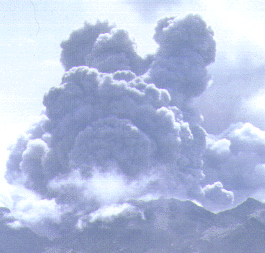AEROSOL GROUP
Volcanoes and Climate
Volcanic eruptions spew large amounts of dust and ash into the atmosphere. They also produce large quantities of carbon dioxide and sulphur dioxide. The sulphur dioxide is quickly converted into sulphuric acid droplets in the stratosphere. If the eruption is large and tropical, any material in the stratosphere can rapidly circulate the globe and be transported polewards. The extra stratospheric aerosols can reflect solar radiation and hence cause a negative radiative forcing. Since the stratosphere is cold, the aerosol can also act as a greenhouse gas, absorbing infra-red radiation emitted by the surface, and re-emitting much less radiation to space. The aerosol distribution can also affect the atmospheric circulation. An excellent review of the impact of volcanoes on climate is that by Robock (2000).

|
Mt. Pinatubo erupted in 1991 and produced a large cloud of sulphuric acid. The peak global mean radiative forcing due to that eruption was 4 Wm-2. Satellite observations show a cooling of the Earth's surface and a warming of the lower stratosphere (absorption of radiation by aerosol) of a few tenths of a degree. |
It's not just explosive eruptions that
can affect climate. The continuous eruptions of these leaky volcanoes are a
constant and important part of the natural sulphur dioxide budget. Few of these
individual eruptions are big or long lived enough to cause a climate impact.
However, in 1783, the Laki eruption in Iceland put a large amount of sulphur
dioxide into the lower troposphere over a period of 8 months. Despite the fact
that there appears to have been not much material put into the stratosphere,
Benjamin Franklin suggested that a warm summer and cold winter that followed
the eruption may have been due to the atmospheric distribution of sulphuric
acid. There are many descriptions of a "dry fog" persisting over much
of Europe throughout summer 1783.
Together with Dr David Stevenson of University of Edinburgh, we have attempted
to quantify the temeprature response to this eruption. Using a chemical
transport model, STOCHEM-Ed, David has simulated the sulphate aerosol
distribution in the 2 years after the eruption. We have used these fields in
the Reading Intermediate General Circulation Model to simulate the climate
response.
Result
We find that the Northern Hemisphere mean temperature was depressed by around -0.14 deg C compared to a year with no Laki eruption, in good agreement with observational studies. There is considerable spatial variation in the temperature response.Highwood and Stevenson (2003). Click here for an acrobat (.pdf) version (80 kb)
Part 1 of this study: Stevenson et al (2003) (chemistry modelling). Click here for an acrobat (.pdf) version (80 kb)
For great pictures of volcanic landscapes look at: